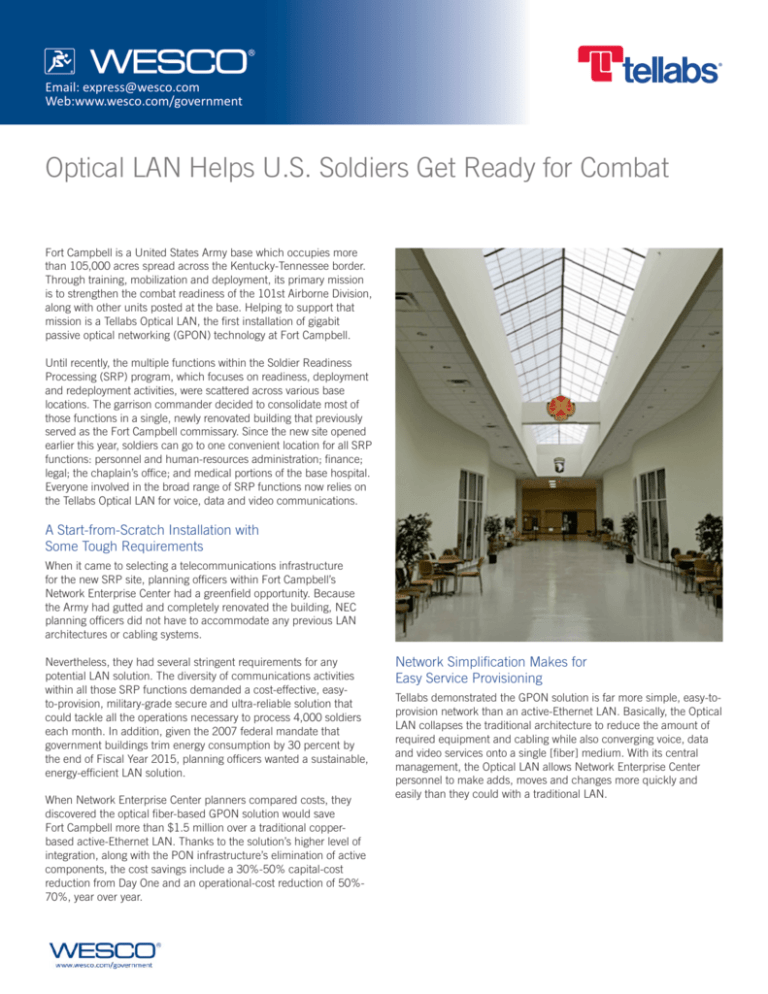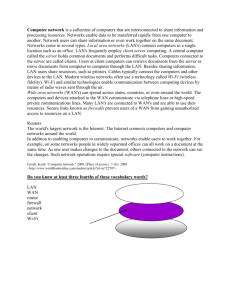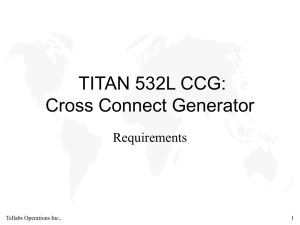
CASE STUDY
Email: express@wesco.com
Web:www.wesco.com/government
Optical LAN Helps U.S. Soldiers Get Ready for Combat
Fort Campbell is a United States Army base which occupies more
than 105,000 acres spread across the Kentucky-Tennessee border.
Through training, mobilization and deployment, its primary mission
is to strengthen the combat readiness of the 101st Airborne Division,
along with other units posted at the base. Helping to support that
mission is a Tellabs Optical LAN, the first installation of gigabit
passive optical networking (GPON) technology at Fort Campbell.
Until recently, the multiple functions within the Soldier Readiness
Processing (SRP) program, which focuses on readiness, deployment
and redeployment activities, were scattered across various base
locations. The garrison commander decided to consolidate most of
those functions in a single, newly renovated building that previously
served as the Fort Campbell commissary. Since the new site opened
earlier this year, soldiers can go to one convenient location for all SRP
functions: personnel and human-resources administration; finance;
legal; the chaplain’s office; and medical portions of the base hospital.
Everyone involved in the broad range of SRP functions now relies on
the Tellabs Optical LAN for voice, data and video communications.
A Start-from-Scratch Installation with
Some Tough Requirements
When it came to selecting a telecommunications infrastructure
for the new SRP site, planning officers within Fort Campbell’s
Network Enterprise Center had a greenfield opportunity. Because
the Army had gutted and completely renovated the building, NEC
planning officers did not have to accommodate any previous LAN
architectures or cabling systems.
Nevertheless, they had several stringent requirements for any
potential LAN solution. The diversity of communications activities
within all those SRP functions demanded a cost-effective, easyto-provision, military-grade secure and ultra-reliable solution that
could tackle all the operations necessary to process 4,000 soldiers
each month. In addition, given the 2007 federal mandate that
government buildings trim energy consumption by 30 percent by
the end of Fiscal Year 2015, planning officers wanted a sustainable,
energy-efficient LAN solution.
When Network Enterprise Center planners compared costs, they
discovered the optical fiber-based GPON solution would save
Fort Campbell more than $1.5 million over a traditional copperbased active-Ethernet LAN. Thanks to the solution’s higher level of
integration, along with the PON infrastructure’s elimination of active
components, the cost savings include a 30%-50% capital-cost
reduction from Day One and an operational-cost reduction of 50%70%, year over year.
Network Simplification Makes for
Easy Service Provisioning
Tellabs demonstrated the GPON solution is far more simple, easy-toprovision network than an active-Ethernet LAN. Basically, the Optical
LAN collapses the traditional architecture to reduce the amount of
required equipment and cabling while also converging voice, data
and video services onto a single [fiber] medium. With its central
management, the Optical LAN allows Network Enterprise Center
personnel to make adds, moves and changes more quickly and
easily than they could with a traditional LAN.
See tellabs.com for more information about Tellabs Solutions
2 OPTICAL LAN HELPS U.S. SOLDIERS GET READY FOR COMBAT
Email: express@wesco.com
Web:www.wesco.com/government
Not Just a Greenfield Installation But a Green One, Too
A Technology that Secures Military Communications
In terms of sustainability, the Tellabs Optical LAN produces fewer
thermals and therefore delivers energy savings of up to 80%
when compared with traditional copper-based LANs. Its passive
architecture requires no power within the optical distribution
network, i.e., the physical fiber and optical devices that distribute
signals to end users. Further, the Optical LAN’s need for less
equipment than a copper-based LAN has a domino effect on many
other power-related areas, including distribution and switching gear,
conversion, backup, fire suppression and cooling.
Recognizing the need for secure communications within all military
and government installations, Tellabs designed the Optical LAN
to provide a comprehensive set of security options, ranging from
advanced end-user authentication, deep packet filtering and optical
encryption to secure remote management with IPSEC, IPv4/v6,
SNMPv3, role-based access and security audits.
In addition, optical fiber is not susceptible to the electromagnetic
radiation concerns associated with copper wiring, and Optical LAN
electronics are far more secure from intrusion than edge switches.
To support future high-security requirements, Tellabs installed the
infrastructure with armored interlocking fiber cabling and secure
zone boxes. With the addition of the fiber alarm-monitoring system
to create the alarm points, the Optical LAN can support Tellabs™
All-Secure PON. Once enabled, this security layer of protection
directly monitors, on a 24/7/365 basis, each armored single-mode
fiber, and any attempt to intercept communications triggers an alarm.
A Simple Solution that Supports a Broad Array
of Services
A Powerful Optical LAN with a Small Footprint
and Low TCO
Tellabs also showed the Fort Campbell planners that the Optical
LAN, by reducing cabling, floor, rack and telecom closet
requirements, could save a lot of physical space within the building.
For example, a typical copper-based LAN serving up to 2,000 users
requires 90 rack units of space. Active-Ethernet LAN switches
require one full rack for the switches and two additional racks for
terminating the large bundles of copper cables associated with the
switches—for a total of 18 seven-foot-tall equipment racks.
By contrast, an Optical LAN can serve up to 8,000 users and,
because the optical line terminal (OLT) features 90% greater density
than active-Ethernet switches, an Optical LAN requires only one
equipment rack and a total of 11 rack units within the equipment
rack. Further, by reducing the amount of physical space required,
an Optical LAN brings with it fewer UPS, fire suppression, and HVAC
requirements which, in turn, reduces overhead costs. The PON
splitters, typically located in the telecom closet, are located in a
fiber distribution hub (FDH) mounted on the wall; thus reducing the
required floor space even more.
Working around the ongoing
construction and renovation
of the former commissary
building, Tellabs installed the
SRP Optical LAN within a few
months. At the heart of the
solution is the Tellabs 1134
Optical Line Terminal (OLT), a
four-rack unit chassis which
resides in the building’s only
telecom closet. Capable of
supporting 512 ONTs, the
Tellabs 1134 OLT concurrently
provides 2,048 Ethernet ports
and up to 1024 analog POTS
lines. The platform’s IP/Ethernet
architecture supports the
scalable delivery of multiple
services simultaneously,
including:
plain old telephone service
(POTS)
n
native Session Initiation Protocol (SIP)-based Voice over Internet
Protocol (VoIP)
n
high-speed Internet access
n
The Fort Campbell planners realized that when they factor in training
and support expenses with the above-mentioned cost savings, the
Tellabs Optical LAN offers the base a significantly lower total cost of
ownership over 10 years, compared to a copper-based LAN.
transparent LAN data services
n
video, including Internet Protocol Television (IPTV), RF video and
Video on Demand (VoD)
n
See tellabs.com for more information about Tellabs Solutions
3 OPTICAL LAN HELPS U.S. SOLDIERS GET READY FOR COMBAT
Email: express@wesco.com
Web:www.wesco.com/government
Connected to armored fiber that runs down the building risers,
the 1134 OLT delivers a 1-Gbps connection to the Tellabs 705GR
Optical Network Terminal (ONT) located on each desk throughout
the building. The 1134 OLT also aggregates all user traffic and feeds
it, via a 1-Gbps Ethernet connection, to the transport-network router.
The 705GR ONT, which features four 1-Gbps Ethernet data
ports, two analog ports and an RF connector, can deliver multiple
services simultaneously over a single fiber to each individual desk
or workstation: POTS or Voice over IP (VoIP); RF or IP Video; and
1-Gbps Ethernet data. To satisfy the requirement for 300-plus drops
in the building, Network Enterprise Center planners installed 200
705GR ONTs for the first phase of the two-phase deployment and
have ordered 200 additional units to round out the second phase.
Voice Gateway Bridges Legacy and Advanced Gear,
Saves More Money
To provide telephone service over the passive optical network, the
Tellabs Optical LAN connects the two 705GR analog ports, via the
Tellabs 1000 Voice Gateway, to Fort Campbell’s existing Class 5
PBX, which is located in another building on the base. By bridging
Fort Campbell’s legacy TDM-based voice infrastructure to the FTTD
VoIP architecture, the Voice Gateway enables the Optical LAN to
deliver POTS service over the common GPON fiber infrastructure,
thereby eliminating the need for any overlay network and TDM-IPTDM conversions.
The solution’s TDM-to-IP flexibility produces even more cost savings
for the base. Fort Campbell can protect its existing investment in the
PBX, and there is no need to purchase VoIP handsets and licenses.
SRP personnel moving from other buildings into the new site keep
their current telephone numbers and their familiar processes for
making and transferring calls, retrieving voice-mail messages, etc.
Optical LAN Flexes Easily to Accommodate More Users
The new SRP site occupies more than 40,000 square feet of
space of the 110,000-square-foot building. Fort Campbell officials
plan to move the New Soldier In/Out Processing Center, as well
as the Military Personnel office, into the remaining portions of the
renovated building. The latter includes several communicationsintensive sections, among them ID cards; insurance sign-ups for
soldiers and their families; dental services and records; transition
services; finance; and reassignments. When combined with
the SRP operations, the other operations slated to move into
the building are certain to generate a lot of bandwidth-intensive
communications traffic.
With its scalable, gigabit Ethernet capacity and its fast, easy service
provisioning, the Tellabs Optical LAN at Fort Campbell stands ready
to serve all those who serve.
Next Steps: Visit www.tellabs.com to learn
more about how Tellabs Optical LAN
Solutions are solving enterprise network
challenges while significantly reducing
CapEx and OpEx, power consumption and
space requirements. If you have a question
about Tellabs Optical LAN Solutions, please
email ask@tellabs.com.
North America
Asia Pacific
Europe, Middle East & Africa
Latin America & Caribbean
Tellabs
1415 West Diehl Road
Naperville, IL 60563
U.S.A.
+1 630 798 8800
Fax: +1 630 798 2000
Tellabs
350 Orchard Road
#18-01 Shaw House
Singapore 238868
Republic of Singapore
+65 6572 5600
Fax: +65 6572 5601
Tellabs
St Johns Court
Easton Street
High Wycombe, Bucks
HP11 1JX
United Kingdom
+44 871 574 7000
Fax: +44 871 574 7151
Tellabs
Rua James Joule No. 92
EDIFÍCIO PLAZA I
São Paulo – SP
04576-080
Brasil
+55 11 3572 6200
Fax: +55 11 3572 6225
The following trademarks and service marks are owned by Tellabs Operations, Inc., or its affiliates in the United States and/or in other countries: TELLABS®, TELLABS and T symbol®, T symbol® , and SMARTCORE®. Statements herein may contain
projections or other forward-looking statements regarding future events, products, features, technology and resulting commercial or technological benefits and advantages. These statements are for discussion purposes only, are subject to change and are
not to be construed as instructions, product specifications, guarantees or warranties. Actual results may differ materially. The information contained herein is not a commitment, promise or legal obligation to deliver any material, code, feature or functionality.
It is intended to outline Tellabs’ general product direction. The development, release and timing of any material, code, feature or functionality described herein remains at Tellabs’ sole discretion.
© 2014 Tellabs. All rights reserved.










